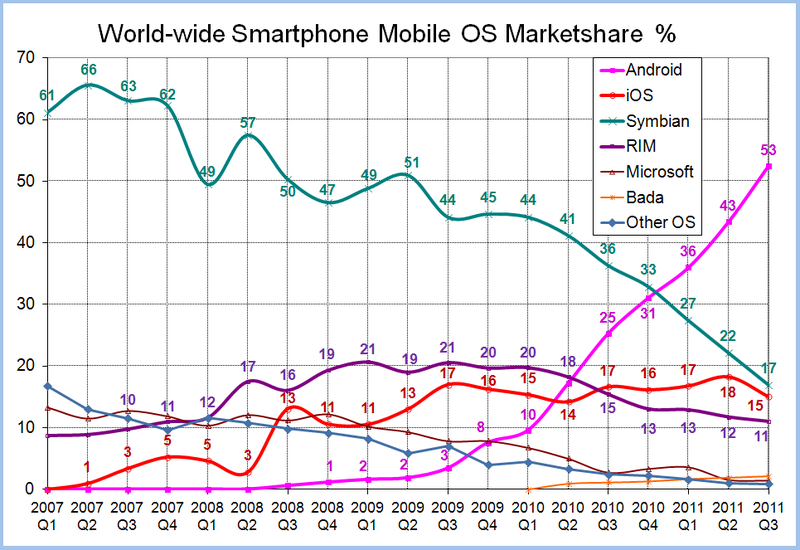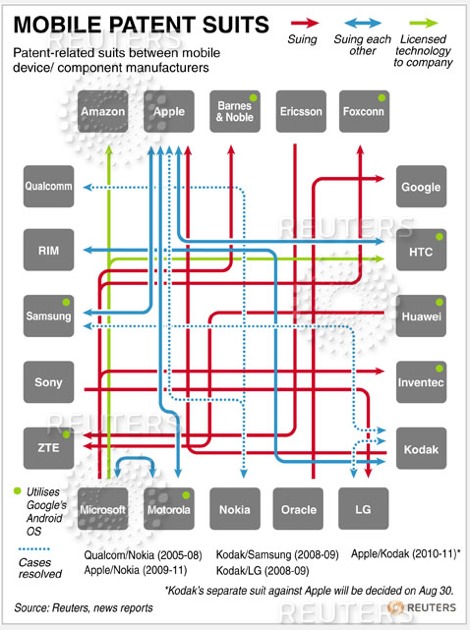Being a techno addict and early adopter for all kinds of mobile technologies, I’d like to share my growing frustration regarding a major lack of creativity & innovation in the mobile market over the last twelve months.
Even if Apple and Google were working silently on mobile operating systems in 2007, Apple was the first (followed the year after by Google) to ignite a fire under the well-established mobile players dominance. Since then, the two new players have acquired almost the full market and left some crumbs to RIM and their Blackberry services and Microsoft with their Windows Mobile solutions.

Thanks to this incredibly fast growing technology, we have seen a tremendous amount of fantastic innovations, from a user experience perspective, embedded native application and from massive hardware improvement from Apple and all the vendors who have embraced the Android family (mostly HTC, SAMSUNG, Motorola and some others)
That said, since early 2011, we have to admit that, aside from the availability of faster processors and larger/brighter screens, no real “whoaaa” innovation has been introduced to the market that would enable some new usage, especially from a business perspective.
So, we can ask the following question: has mobile technology already become mature and saturated?
No and for some very simple reasons. We have now all become quite used to enjoying these new mobile technologies as part of our professional/private lives and the freedom that comes with them. However, as good spoiled users as we all are, we always want and dream about more features to simplify our experience and boost new “business on the go” usages such as:
human interfaces
From my perspective, the space where most incredible innovations could be delivered is “human interface” technology. Among many other, this would includes
- Advanced Motion Features (eye and face motion),
- real & effective voice recognition and interpretation (not like the still "beta" Siri or Google voice),
- gesture recognition (imagine all the potential that can be added if you could browse your device without even touching it).
new business usages based on human interfaces
- field people not needing to touch physically the screen to interact with the device.
- medical workers working in a sterile environment who need to interact with a device without touching it in order to avoid bacteria transmission
- securing devices and confidential information with retina ID and multiple facial patterns. physical unique checks
next-generation hardware
Instead of focusing on current technology improvements, I do believe that the vendors should really move one step beyond by delivering new technology that allows a full range of new usages.
Below are some examples of new hardware technologies that could enable and support some fantastic new usages and applications in the workplace:
- 3D screen with 3D applications,
- hologram screen,
- screen with embedded transparent solar panel for a decent usage length ( and to bypass the battery limitation issue),
- embedded virtual laser keyboard.
new business usages based on – next-generation hardware
- 3D screen that is clearly multimedia oriented but could lead to new usages such as business-grade videoconferencing or any other remote 3D video interactions (remote trouble shooting, medical exams, engineering…)
- Hologram screens would be very useful for all types of hands-free usage or medical usage in sterile environments.
- Embedded transparent solar panel would offer business-grade devices longer usage times. This new source of power could also enable additional device features that were, up until this point in time, not included due to their high battery consumption.
I am not a mobile vendor/manufacturer and do not have the pretention to foresee the future but, this next step in term of technology is, for me, a clear way to boost sales of new devices by enabling more and more business usage potentials and therefore, empowering mobile devices within the businesses.
So now, let’s see and bet in what direction the industry will push us and what type of “ WOAAA” effect they will deliver unless, they decide to limit the innovation by a minimum and will prefer to spend tremendous amount of money in sterile (from users perspective) patent trail against each other’s.

many thanks and have a nice day
Philippe
